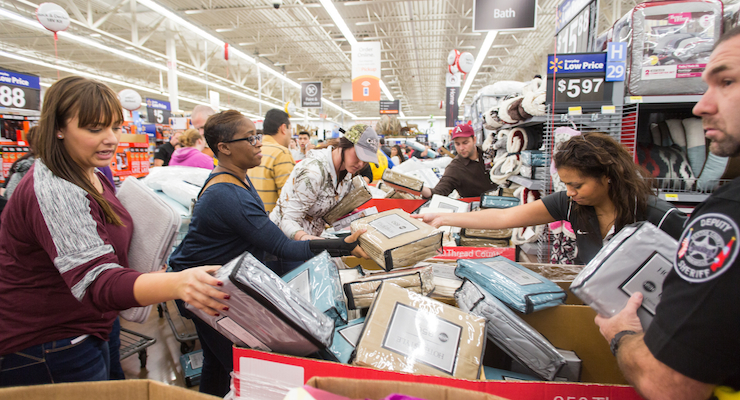

Customers at Walmart’s Black Friday shopping event on Thursday, Nov. 26, 2015 in Rogers, Ark. (Photo by Gunnar Rathbun/Invision for Walmart/AP Images)
Wal-Mart is seeing the future, and the future isn’t more shoppers driving through stop-and-go traffic to big boxes at the edge of town. It’s online shopping. The giant retailer plans to plunk down a princely $3.3 billion for Jet.com, an e-commerce company. Using the same crystal ball, Macy’s says it will close at least 100 stores, many in malls that have seen better days.
Where does retailing in our city centers and on our Main Streets fit into this story? The answers are not simple.
In the beginning, Americans went downtown to buy everything from hammers to sweaters to footballs. When much of the middle class departed for the suburbs, the retailers followed them. The new shopping venues were big-chain discounters and giant malls. This mass transfer drained the life out of downtown retailing, leaving sad, empty storefronts on architecturally splendid streets.
Nowadays, “the Darwinian thing is going on in suburban retailing that was happening downtown,” Mark Cohen, retailing expert at Columbia Business School, tells me.
Amazon.com is the undisputed king of that jungle. Its online mega-store sells 550 million products. Every year, it takes a bigger bite out of bricks-and-mortar store sales.
Another weight on suburban retailing is a ludicrous overbuilding of retail space. “The developers never saw a highway and exit ramp that they didn’t want to build a mall on,” Cohen quipped.
So what happens next? Many of the fringe developments further down the highway without full tenancy are going to be history, according to retail analysts. Some big boxes, such as Home Depot and Lowe’s, may do OK. Others will not.
On to our downtowns. Whether hopping with activity, on the mend or still ailing, they remain the center for much of our civic life. Downtown is where one finds city or town hall, a main post office, a good library and transportation hubs. The stores are key players in the experience.
Will online shopping hurt Main Street retailing the way it has plagued suburban stores? That all depends on the downtown.
Where there is gentrification — wealthier people moving to urban neighborhoods — there is, of course, retail opportunity. Another advantage for city and town shopping districts is foot traffic, people walking by storefronts.
Take me. I’m one of Amazon Prime’s valued customers. I click away for moth traps and patio lights and color printers that get delivered to my doorstep. I know exactly what a Lego Elves toy is and would not sacrifice a half-hour driving for something I can order online in five minutes.
But shopping does remain a part of the entertainment mix. On Saturday afternoons, folks hang out in nearby shopping districts. The stores there display clothes and housewares more interesting than the commodities at the discounters’. And being seduced by an artful display window could be a byproduct of meeting someone two doors down for coffee.
Many of the most successful retail districts are those that attract tourists, particularly foreign ones. Visiting Asians, Russians and South Americans are known to stuff empty suitcases with stuff bought here. The concern right now is the higher American dollar — plus the threat of another travel-related terrorist attack.
The good news for physical retailers everywhere, Cohen says, is that the internet isn’t likely to take it all. About 15 percent of current retail sales, online shopping could possibly go as high as 40 percent, but that would still leave at least 60 percent.
And so the dreamscape of a bustling Main Street persists. Every now and then, one comes across a surviving family-run sporting goods or shoe store — and salutes. It would be awfully nice to see more of them.
The most damning journalistic sin committed by the media during the era of Russia collusion…
The first ecological study finds mask mandates were not effective at slowing the spread of…
On "What Are the Odds?" Monday, Robert Barnes and Rich Baris note how big tech…
On "What Are the Odds?" Monday, Robert Barnes and Rich Baris discuss why America First…
Personal income fell $1,516.6 billion (7.1%) in February, roughly the consensus forecast, while consumer spending…
Research finds those previously infected by or vaccinated against SARS-CoV-2 are not at risk of…
This website uses cookies.